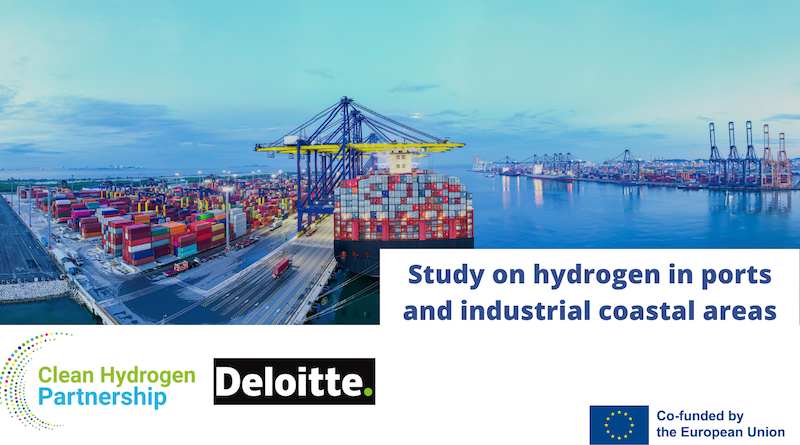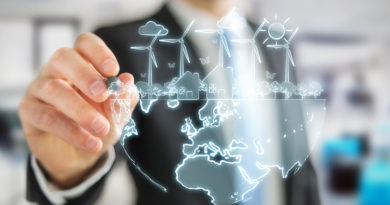
Developing ports hydrogen infrastructure is crucial for the greening of the European economy
Ports will be key hubs for the integration of hydrogen into Europe’s energy mix. However, according to a first report recently by Deloitte Belgium for the Clean Hydrogen Partnership, the EU will have to “radically accelerate” the development of infrastructure at ports and the surrounding industrial areas to meet its renewable hydrogen targets.
Ports and their industrial areas will play a crucial role in boosting the use of hydrogen as part of the EU’s plan to achieve a sustainable and green economy. This role includes their use as hubs through which hydrogen will be imported and distributed. Ports will also be big investors in the dedicated infrastructure needed to produce, import, store, and distribute hydrogen to industries in the surrounding areas.
The EU’s sustainable energy plan, REPowerEU, set a 2030 target of 10 million tonnes of renewable hydrogen production in the EU and 10 million tonnes of renewable hydrogen imports.
Achieving this target while continuing to expand the European hydrogen market through to 2050 would require the EU to “radically accelerate the deployment of hydrogen production, import terminal, reconversion, storage, transportation, and consumption infrastructure capacity in port ecosystems,” the report states.
Up to 42% of the EU’s total hydrogen demand could be located in port areas by 2050 according to the Deloitte study. However, all stakeholders must work together to develop a long-term plan for investment in ports hydrogen infrastructure.
Accelerating the hydrogen infrastructure in ports and their capacity as hydrogen transit hubs is an important step towards building the hydrogen economy and our study clearly shows it. With ports and industrial coastal areas expected to account for 42% of the annual hydrogen demand across the EU we need to work together for the development of a European Hydrogen Ports Roadmap that can unlock the ports areas’ full decarbonisation potential.
Specific results for over 400 ports
The report is the first of three to be released this year. These studies will feed into a roadmap to increase the development of ports’ capacity to handle, use and distribute hydrogen as an energy source.
This first study publishes specific results for each of the 427 European seaports and inland ports looking at future hydrogen demand and supply, the related CO2 equivalent abatement, and a forecast of the required infrastructures needed for 2030, 2040 and 2050.
Port authorities and policymakers can use an online dynamic dashboard to view these scenarios and results as a means of gaining insights to feed into their planning.
The dashboard provides information on the potential hydrogen demand and related CO2 abatement at specific ports, from where and at what cost this demand could be supplied, and which infrastructure and investments could be required to achieve the full benefits of the technology.
Demand to increase significantly
According to the study, in the most ambitious market-driven demand scenarios, annual hydrogen demand across the EU is forecast to increase significantly by 2050, up to about 53 Mt, with 42% of this demand stemming from port areas.
This demand in port areas is expected to be mainly driven by industry and the international shipping sector. Industry could account for 42% of demand and shipping from 31% by 2050.
This fast and large uptake of energy from hydrogen has the potential to lead to an abatement of up to 360 Mt of CO2-eq in 2050, representing 8% of Europe’s total greenhouse gas emissions in 2019. The increasing use of the technology could lead to additional environmental benefits, such as the reduction of toxic atmospheric emissions, water pollutants, solid waste and noise.
Deloitte concludes that the share of hydrogen import in total hydrogen consumption in the EU could range between 25% and 70% in 2050 according to a cost optimisation model used for the study.
This share would depend mostly on the ability of EU countries to rapidly increase the rate of deployment of local renewable energy production capacities such as solar photovoltaic systems and onshore and offshore wind.
The largest hydrogen demand would come from Belgium, Netherlands, Denmark and Germany’s northern regions in all scenarios. Deloitte expects that these countries will import between 40% to 80% of their total hydrogen consumption mainly from Morocco, Egypt, Algeria, Oman, Saudi Arabia and Qatar.
Imports from countries such as Australia could even be in the mix. Meanwhile some intra-European hydrogen exports and imports can also be expected, such as trade from Spain to France.
The report provides estimates for the required investment needed for all aspects of hydrogen production, imports, conversion, storage, transportation and consumption. This includes the investment needed for refuelling stations and hydrogen bunkering.
Hydrogen pilots at Valencia’s port
The Clean Hydrogen Partnership has already started the process of developing port infrastructure through its investment in the H2Ports project at the Spanish port of Valencia.
The project aims to demonstrate and validate hydrogen technologies at the port over two years in real use situations. These include a hydrogen mobile supply station specifically designed for the project, a reach stacker machine designed to move shipping containers over short distances and a yard tractor.
The reach stacker and tractor will run on fuel cells and electric motors, which will be powered by hydrogen and will be zero-emission.
These pilots will be Europe’s first experience of the use of hydrogen-powered fuel cell technology in port handling equipment.
Hydrogen, especially hydrogen derived from renewables, is expected to be critical as a substitution for fossil gas, coal, and oil in hard-to-decarbonise sectors. These include refineries, producers of ammonia, steel and chemicals, and heavy-duty road freight, shipping, aviation transport.
What’s next
The Study on hydrogen in ports and industrial coastal areas will be followed by a second report which will provide information on policy, regulations, governance, strategy and other non-technical requirements needed for the development of hydrogen technology at the EU’s ports.
The report will also identify the priority areas for investing in research and innovation projects and the required safety regulations, codes, and standards needed for EU ports and areas.
The third report, expected by the end of the year, will examine several case studies highlighting the feasibility of developing a range of hydrogen-related activities and infrastructures in the vicinity of ports.
In parallel, European Hydrogen Ports Network events will be organised during the study to bring the main European representatives of the port ecosystem together to exchange, connect and take a long-term perspective on hydrogen take-up in European ports.
These activities aim to enable the creation of a European Hydrogen Ports Roadmap.
FIND OUT MORE
The Clean Hydrogen Partnership is a public-private partnership of the EU, industry and research organisations to fund R&D in hydrogen technologies.
Study on hydrogen in ports and industrial coastal areas.
Study dashboard – stakeholders contact Sofie De Brabander at Deloitte .




